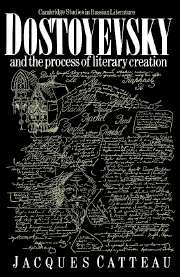Book contents
- Frontmatter
- Contents
- Preface to the English edition
- List of abbreviations
- General editor's note on transliteration and references
- General introduction
- PART I The creative environment
- PART II The process of creation
- Part III Time and space in the world of the novels
- Introduction
- 19 The master of men and hours
- 20 Chronology and temporality in The Idiot
- 21 The ascending spiral
- 22 Time of power and power of time
- 23 The havens of eternity
- 24 The dream of space and the space of the real
- 25 The inventory and the expressionist orchestration of scenery and lighting
- 26 The semantics of colour
- 27 The hero in space: sighting and seeing
- Conclusion
- Notes
- Select bibliography
- Index of names
Introduction
Published online by Cambridge University Press: 18 December 2009
- Frontmatter
- Contents
- Preface to the English edition
- List of abbreviations
- General editor's note on transliteration and references
- General introduction
- PART I The creative environment
- PART II The process of creation
- Part III Time and space in the world of the novels
- Introduction
- 19 The master of men and hours
- 20 Chronology and temporality in The Idiot
- 21 The ascending spiral
- 22 Time of power and power of time
- 23 The havens of eternity
- 24 The dream of space and the space of the real
- 25 The inventory and the expressionist orchestration of scenery and lighting
- 26 The semantics of colour
- 27 The hero in space: sighting and seeing
- Conclusion
- Notes
- Select bibliography
- Index of names
Summary
In the notebooks for A Raw Youth Dostoyevsky approaches the space-time structure he had planned in The Life of a Great Sinner', especially in the brief period when this unwritten work appeared as a plan in his letters. The link between the two subjects is obvious. During the research the original character of the Great Sinner, of whom Stavrogin was the larva incapable of metamorphosis, has somehow suffered a double change: it has spread out over space and has contracted in time. It has split into the three characters of Versilov, the impenitent sinner, Makar Ivanych, the man of God, and Arkadiy, the raw youth, who is the son of both of them and who occupies a central position, as the human architecture showed us, forging a path to order through the disorder that surrounds him. Time is contracted because the whole life of the hero is no longer the subject of the novel; all the experiences which the Great Sinner would have had from childhood to death have been concentrated in one great crisis during the hero's adolescence. The Raw Youth only has a few of these experiences; the others appear as impulses within the youth or as actions which he witnesses, since besides being subject to experiences, the Raw Youth chronicles and spies on the experiences of others.
The space-time structure of A Raw Youth is less ambitious than the structure formerly envisaged for The Life of a Great Sinner', but its intention is the same; to reconcile the antinomic freedoms of the novelist and his hero in the writing, and the opposing freedom of God and man in the sphere of thought.
- Type
- Chapter
- Information
- Publisher: Cambridge University PressPrint publication year: 1989



